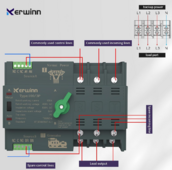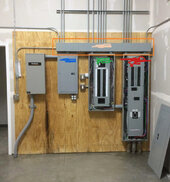timselectric
If I can do it, you can do it.
- Joined
- Feb 5, 2022
- Messages
- 19,792
Either/ orThe single neutral line to the inverter is carrying the neutral currents from the GRID input/output (varies) to the inverter *AND* the LOAD output.
Not and
The inverter can't be a source and load, at the same time.
Correct, but it's still one circuit from one source.The single neutral between main and backup panels is carrying the neutral currents from both the inverter GRID input/output (varies) *AND* the backup panel if it is in grid mode.
It's not two circuits. It's two optional sources for one circuit.NEC 200.4(A):
Neutral conductors shall not be used for more than one branch circuit, for more than one multiwire branch circuit, or for more than one set of ungrounded feeder conductors unless specifically permitted elsewhere in this Code.
The interlocks keep them from being used simultaneously.
Most of the newer hybrid AIO's have a single neutral bar.No, my inverter has a neutral connection for the GRID and the LOAD that are separate.
Your should be internally common. (Please verify)
You have two options.
1. Only use the input neutral terminal. (Assuming that it's the larger one)
2. Run both to the terminal block in the trough.
(#1 would be my choice)
See aboveAgain, simply tell me how you wire those four points together and not combine neutral current from two circuits and without creating a neutral loop? I can't see anyway to do this.
I wouldn't do that. Because you can't isolate the backup panel for maintenance.The simplest would be to send every neutral to the backup panel neutral bar.
Without shutting down the inverter. And there may be times when that would not be desirable.
Again, this would be parallel conductors. (Not recommend)The separate inverter neutrals are basically tied together at both ends, so that's electrically one wire so they will share current and not be segregated.
And requires keeping the backup panel neutral bar active, when maintenance is done. (Unless you also shut down the inverter)
A warning label would be needed.
Hopefully this cleared up some questions.I am going to be wiring this up in a few days, so I am keen to figure this out.
I would definitely use a trough. It makes everything simpler and looks much cleaner.




